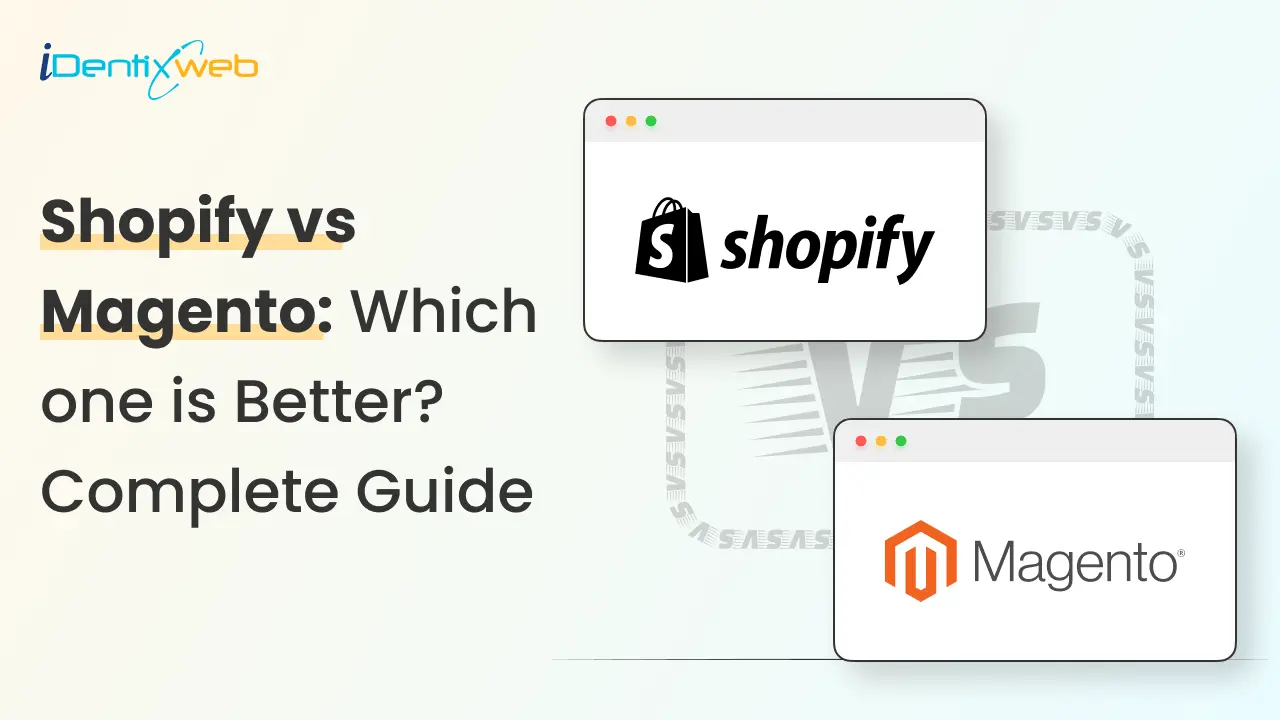
If you’ve been running an online store for a while, you already know this: The platform you choose can either smooth out your operations or make every change expensive.
That’s why the Shopify vs Magento debate still matters in 2025.
Over the past year, AI has become a core part of the buying journey. Shoppers expect personalized recommendations, faster delivery updates, and a checkout that doesn’t make them think twice.
At the same time, CAC continues to climb, which, according to 2025 data, is between $60-70.
This simple guide is about to save you hours!!
If you’re an online brand trying to figure out whether Magento or Shopify gives you the power to scale, this breakdown is for you.
Quick Review & Verdict
Shopify is best for: Better overall. Brands that want a fast, low-maintenance platform that helps them launch quickly and scale without heavy technical work.
Magento is best for: Businesses that need deep customization, complex workflows, and have the development resources to support a highly tailored ecommerce setup.
What is Shopify?
Shopify is an ecommerce platform that lets you create and run an online store without touching a code. Everything you need, your website, checkout, inventory, payments, and marketing tools, lives inside one clean, easy-to-use dashboard.
You can launch a store in hours, not weeks, even if you’ve never built a site before.
What I like & dislike about Shopify?
| What I Like | What I Dislike |
| You can set up your store, upload products, and start selling without developers. | Advanced features often require multiple paid apps, which can increase your monthly costs. |
| Shopify handles PCI compliance, SSL, patches, and uptime so you can focus on marketing, sales, and CX. | You’re limited by Shopify’s framework for deep customization and complex, custom logic. |
| You get easy access to apps for upsells, subscriptions, reviews, loyalty, email, SMS, and shipping. | You don’t have full server-level control over performance, hosting, or backups. |
| You can sell across marketplaces, social platforms, retail POS, and international storefronts from one ecosystem. | You’re more tied into Shopify’s ecosystem, which can make major technical or platform shifts harder later. |
“We decided to move to Shopify as we believe it provides us with the most future-proof way to think about commerce.”
Usama Dar — CTO, Westwing
How much will Shopify cost?
| Plan | Monthly Cost | Best For |
| Basic | ~$29/month | New or early-stage brands |
| Grow | ~$79/month | Growing brands with steady sales and a team |
| Advanced | ~$299/month | Scaling stores needing detailed reporting and operations |
| Plus | ~$2300/month | High-volume or enterprise brands |
What is Magento?
Magento is an open-source ecommerce platform designed for businesses that want full control over every part of their online store.
It offers deep customization, advanced workflows, and the flexibility to build complex shopping experiences with the help of a dedicated development team.
What I like & dislike about Magento?
| What I Like | What I Dislike |
| You can build highly customized store logic, workflows, and product configurations. | You almost always need developers or an agency to build your store. |
| Your business can lean on an in-house technical team. | Setup and ongoing maintenance (hosting, patches, security) add extra cost and complexity. |
| You can manage complex catalogs, multi-store setups, and enterprise-level operations. | Non-technical teams may find the admin and system harder to use day to day. |
| You have full control over hosting, performance, and backend infrastructure. | Poor implementation or cheap hosting can cause performance issues that directly impacts revenue. |
| You can support advanced personalization and deep integrations with internal systems. | If your needs change and you want something simpler later, moving away from a heavily customized Magento build is tough. |
How much will Magento cost?
| Component | Cost |
| Platform License | $0 / year (no license fee) |
| Hosting | ~$100 – $6,500 / year (shared → dedicated/VPS) |
| Initial Development | ~$5,000 – $10,000+ (build, theme, customizations) |
| Extensions & Themes | ~$50 – $1,000+ per item |
| Maintenance & Support | ~$500 – $2,000+ / month (support, updates, small dev) |
| Estimated Annual TCO | Roughly $12,000 – $60,000+ / year |
Shopify vs Magento: Comparison
| Feature | Shopify / Shopify Plus | Magento (Adobe Commerce) |
| Ease of Use | Very beginner-friendly; non-technical teams can launch and manage day-to-day easily. | Steeper learning curve; most changes go through developers or an agency. |
| Apps / Extensions | Huge app ecosystem; plug-and-play for subscriptions, upsells, loyalty, etc. | Powerful extension marketplace; quality varies, often needs dev review and tuning. |
| Marketing & SEO | Strong basics + tight integrations with popular U.S. tools (email, SMS, ads, SEO). | Very flexible SEO and marketing setup; more control, more dev dependency. |
| AI, Search & Personalization | AI features mostly via apps + newer native tools; fast to implement. | Advanced options via Adobe ecosystem; powerful but best with a strong tech team. |
| Performance & Hosting | Shopify manages performance, CDN, scaling, and uptime globally. | Performance depends on your hosting, caching, and implementation quality. |
| Security & Compliance | PCI, SSL, and platform security handled by Shopify; no server patching on your side. | You must stay on top of patches, server security, and updates (or pay someone to). |
| Scalability | Shopify Markets and expansion stores (Plus) cover multi-region and multi-store needs. | Built for complex multi-store, multi-language, multi-catalog setups from one codebase. |
| Total Cost | Predictable subscription + apps; lower ops overhead, higher speed of iteration. | License (for Adobe Commerce), hosting, plus ongoing dev costs; higher ops overhead. |
Shopify vs Magento: Final Verdict for 2025
Choosing between Shopify and Magento comes down to how your team likes to work. If you want a platform that handles the technical side for you and helps you move faster with fewer roadblocks, Shopify is usually the better fit. It keeps the focus on growth instead of maintenance.
Magento, on the other hand, makes sense when you need full control. If your business depends on complex workflows, custom features, or deep B2B operations, Magento gives you the flexibility to build exactly what you need.
In the end, the best choice is the one that matches your resources and the speed you expect to operate. Shopify delivers a smoother, more efficient path for most modern ecommerce brands, while Magento is ideal for businesses that want customization above everything else.
More comparison articles:
Shopify vs Magento FAQs
1. Which is better, Magento or Shopify?
Both are built for different types of teams. Shopify is a hosted, all-in-one platform that wins on ease of use, faster setup, and lower maintenance, which is why many reviews and head-to-head tests put it ahead for most online stores. Magento (Adobe Commerce) is stronger when you need deep customization, complex B2B logic, and you already have developers or an agency on your side.
2. Do people still use Magento?
Yes, Magento is very much still in use. Recent market data shows well over 100,000 live Magento stores.
3. How to migrate from Magento to Shopify?
Migrating from Magento to Shopify involves three main steps: first, back up your Magento store and set up your Shopify account, then export your data from Magento and import it into Shopify via Litextension. After the import, you’ll review and fix data, set up your theme and apps, run test orders, then update your domain and go live.
4. How much does Shopify cost?
Shopify’s core plans in the U.S. start at $29/month for Basic, $79/month for Grow, and $299/month for Advanced. Shopify Plus is the enterprise option and starts around $2,300/month on a 3-year term.
5. How much does Magento cost?
Magento Open Source has a free license, but you still pay for hosting, domain, SSL, extensions, development, and ongoing maintenance. Adobe Commerce (the licensed version) typically runs $22,000–$125,000+ per year just for the license, with total annual cost much higher once you add hosting and implementation.
6. Is Adobe Commerce the same as Magento?
Adobe Commerce is the enterprise, licensed product built on the Magento codebase. It’s essentially the evolution of what used to be called Magento Enterprise. Magento Open Source continues as the free, community edition, while Adobe Commerce adds extra modules and integrations with Adobe Experience Cloud on top of that core.



![How to Upsell Your Jewelry in Shopify: Proven Tips [2025] How to Upsell Your Jewelry in Shopify: Proven Tips [2025]](/wp-content/uploads/2025/11/21-11-Fri-Blog-The-Only-Tips-You-Need-to-Upsell-Jewelry-in-Shopify.webp)

![How Bike Stores Using Shopify Are Winning [Complete 2025 Guide] How Bike Stores Using Shopify Are Winning [Complete 2025 Guide]](/wp-content/uploads/2025/11/17-11-Mon-Blog-Complete-Guide-to-Selling-Bikes-on-Shopify.webp)

About the author
Vineet Nair
Vineet is an experienced content strategist with expertise in the ecommerce domain and a keen interest in Shopify. He aims to help Shopify merchants thrive in this competitive environment with technical solutions and thoughtfully structured content.